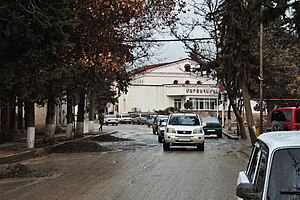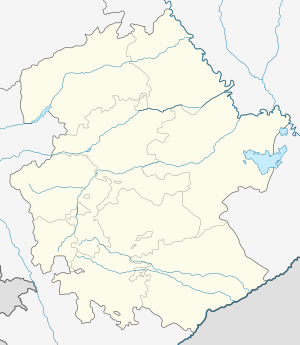Martuni (Armenian: Մարտունի) or Khojavend[2] (Azerbaijani: Xocavənd ) is a town in Khojavend District of Azerbaijan, in the region of Nagorno-Karabakh. Until 2023 it was controlled by the breakaway Republic of Artsakh, as the centre of its Martuni Province, after the First Nagorno-Karabakh War. The village had an ethnic Armenian-majority population[3] until the exodus of the Armenian population of Nagorno-Karabakh following the 2023 Azerbaijani offensive in Nagorno-Karabakh.[4]
Martuni / Khojavend
Մարտունի / Xocavənd | |
|---|---|
 Street | |
| Coordinates: 39°47′43″N 47°06′47″E / 39.79528°N 47.11306°E | |
| Country | |
| District | Khojavend |
| Elevation | 390 m (1,280 ft) |
| Population (2015)[1] | |
• Total | 5,700 |
| Time zone | UTC+4 (AZT) |
| Area code | (+374) 478 |
Etymology
editThe name Khojavend is of Persian origin.[5] The name Martuni originates from the nom de guerre of Armenian Bolshevik revolutionary and official Alexander Miasnikian.
History
editExcavations in the settlement have uncovered a number of tombs dating to the Neolithic and Bronze Age. The town is also home to several ruined medieval churches and remains of settlements, and khachkars have also been preserved.[6]
The town was founded in the medieval period by local Armenians as a village named Khonashen (Armenian: Խոնաշեն), where shen means village and khona, depending on the source, allows different interpretations (namely, “village, dwelling” or “reservoir, well, spring”).[7] The old name of Khonashen originated from the nearby Khonashen river. Traditionally, the village belonged to the Melikdom of Varanda.[8] In 1925, the settlement was transformed into a city and renamed Martuni.[7]
During the Soviet period, Martuni was the capital of the Martuni District in the Nagorno-Karabakh Autonomous Oblast. The population of the town, grouped into kolkhozes, largely occupied itself with raising livestock, grape growing, wheat cultivation, and gardening.[6]
Nagorno-Karabakh conflict
editFirst Nagorno-Karabakh War
editMartuni, and the district itself, became a frontline city during the latter stages of the First Nagorno-Karabakh War. In early February 1992, Vazgen Sargsyan, then Defence Minister of Armenia, appointed Monte Melkonian as Chief of Headquarters and assigned him to lead the defense of Martuni and the surrounding regions.[9] On October 2, 1992, Armenian armed forces captured the region around Martuni. According to an Azerbaijani source, considerable damage was done to the infrastructure of 10 villages settled by Azerbaijanis in the region during the war.[10] Melkonian remained as regional commander until he was killed in combat in June 1993.[11]
2020 Nagorno-Karabakh war
editFrom the very first days of the 2020 Nagorno-Karabakh war (started on 27 September 2020), Martuni was subjected to artillery shelling by the armed forces of Azerbaijan. This led to the disconnection of the city from electricity and gas supply. On 1 November, Azerbaijani aviation launched an airstrike on the city. The Armenian detachments managed to hold their positions in Martuni until a ceasefire was established.
On 15 November 2020, a Russian peacekeeping contingent formed an observation post in the city.[12][13] On 13 February 2021, the specialists of the International Mine Action Center of the Ministry of Defense of the Russian Federation completed the clearance of the territory in the Martuni region.[14] On 1 March, a block-modular town was commissioned for the residence of military personnel of the Russian peacekeeping contingent.[15]
2023 Azerbaijani offensive in Nagorno-Karabakh
editFollowing the 2023 Azerbaijani offensive in Nagorno-Karabakh, the town came under control of Azerbaijani forces on 26 September 2023.[16] Azerbaijan's authorities reportedly dismantled a statue of Armenian militant Monte Melkonian.[17]
Historical and cultural heritage
editThe town has a house of culture commonly called "The Opera", and the Church of St. Nerses the Great, opened in 2004. The Russian 19th-century Gevorgavan Church is located near Martuni.[18]
Economy and culture
editThe population mainly works in agriculture and animal husbandry. In 2015, the town had a municipal building, a house of culture, two schools, a music school, two kindergartens, a youth centre, 36 commercial enterprises, two factories and a regional hospital. The town also includes the villages of Kajavan and Kakavadzor.[19]
Climate
edit| Climate data for Martuni (Khojavend) | |||||||||||||
|---|---|---|---|---|---|---|---|---|---|---|---|---|---|
| Month | Jan | Feb | Mar | Apr | May | Jun | Jul | Aug | Sep | Oct | Nov | Dec | Year |
| Mean daily maximum °C (°F) | 5.5 (41.9) |
6.4 (43.5) |
10.1 (50.2) |
17.5 (63.5) |
21.7 (71.1) |
26.6 (79.9) |
29.8 (85.6) |
29.7 (85.5) |
24.8 (76.6) |
19.1 (66.4) |
12.6 (54.7) |
8.0 (46.4) |
17.7 (63.8) |
| Mean daily minimum °C (°F) | −1.7 (28.9) |
−1.0 (30.2) |
1.8 (35.2) |
7.6 (45.7) |
12.1 (53.8) |
16.4 (61.5) |
19.5 (67.1) |
18.4 (65.1) |
15.2 (59.4) |
10.2 (50.4) |
4.9 (40.8) |
0.6 (33.1) |
8.7 (47.6) |
| Average precipitation mm (inches) | 20 (0.8) |
26 (1.0) |
36 (1.4) |
49 (1.9) |
68 (2.7) |
55 (2.2) |
23 (0.9) |
23 (0.9) |
28 (1.1) |
44 (1.7) |
31 (1.2) |
25 (1.0) |
428 (16.8) |
| Source: http://en.climate-data.org/location/21894/ | |||||||||||||
Demographics
editAccording to the census of 1933, 1028 people lived in the village, divided into 120 households, all of whom were Armenians.[20] The town has an ethnic Armenian-majority population, and also had an Armenian majority in 1989.[21] It had a population of 5,700 as of 2015.[1]
| Ethnic group | 1939[22] | 1970[23] | 1979[24] | 2005[25] | ||||
|---|---|---|---|---|---|---|---|---|
| Number | % | Number | % | Number | % | Number | % | |
| Armenian | 1,701 | 89.2 | 3,120 | 67.0 | 3,588 | 65.3 | 4,863 | 99.7 |
| Azerbaijani | 52 | 2.7 | 1,482 | 31.8 | 1,862 | 33.9 | 0 | 0.0 |
| Russian | 136 | 7.1 | 44 | 0.9 | 41 | 0.7 | 8 | 0.2 |
| Ukrainian | 7 | 0.4 | 3 | 0.1 | 1 | 0.0 | 1 | 0.0 |
| Other | 10 | 0.5 | 5 | 0.2 | 5 | 0.1 | 6 | 0.1 |
| TOTAL | 1,906 | 100.0 | 4,654 | 100.0 | 5,497 | 100.0 | 4,878 | 100.0 |
Gallery
edit-
Church of St. Nerses the Great in Martuni, opened in 2004
-
A street in Martuni
-
A memorial in Martuni
-
Martuni Museum
-
Martuni House of Culture ("The Opera")
-
Municipal building
References
edit- ^ a b "Figures" (PDF). stat-nkr.am. 2015.
- ^ "Map No. 3761 Rev. 8 UNITED NATIONS" (PDF). United Nations.
- ^ Андрей Зубов. "Андрей Зубов. Карабах: Мир и Война". drugoivzgliad.com.
- ^ Sauer, Pjotr (2 October 2023). "'It's a ghost town': UN arrives in Nagorno-Karabakh to find ethnic Armenians have fled". The Guardian. ISSN 0261-3077. Retrieved 9 November 2023.
- ^ Arsène Saparov (2017-09-01). "Contested spaces: the use of place-names and symbolic landscape in the politics of identity and legitimacy in Azerbaijan". Central Asian Survey. 36 (4): 534–554. doi:10.1080/02634937.2017.1350139. S2CID 149221754.
- ^ a b (in Armenian) Anon. «Մարտունի» (Martuni). Armenian Soviet Encyclopedia. vol. vii. Yerevan: Armenian Academy of Sciences, 1981, p. 352.
- ^ a b Поспелов Е. М. [in Russian] (1998). Отв. ред. Р. А. Агеева (ed.). Географические названия мира: Топонимический словарь: Свыше 5 000 единиц. М.: «Русские словари». p. 262. ISBN 5-89216-029-7.
- ^ Hakobyan, Tadevos Kh.; Melik-Bakhshyan, Stepan T.; Barseghyan, Hovhannes Kh. (1991). "Մարտունի [Martuni]". Հայաստանի և հարակից շրջանների տեղանունների բառարան [Dictionary of Toponyms of Armenia and Adjacent Territories] (in Armenian). Vol. 3. Yerevan State University Press. p. 743. OCLC 926872712.
- ^ See Markar Melkonian (2005). My Brother's Road: An American's Fateful Journey to Armenia. New York: I.B. Tauris, pp. 207ff. ISBN 1-85043-635-5.
- ^ "25 years pass since occupation of Khojavend region". 21 June 2020.
- ^ Melkonian (2005), p. 264
- ^ Обстановка в районе проведения миротворческой операции (по состоянию на 15 ноября 2020 г.)
- ^ "Район проведения миротворческой операции (по состояни�� на 18 ноября 2020 г.)". Archived from the original on 2021-03-04. Retrieved 2021-03-04.
- ^ Специалисты Международного противоминного центра Минобороны России завершили работы по разминированию территории в районе н.п. Мартуни
- ^ "Еще четыре новых блочно-модульных городка возведены специалистами МТО для российских миротворцев в Нагорном Карабахе". Archived from the original on 2021-03-01. Retrieved 2021-03-04.
- ^ "Azerbaijan dismantles monument to Armenian terrorist in Khojavend". 26 September 2023.
- ^ "Monument to Armenian terrorist in Azerbaijan's Khojavend dismantled (PHOTO)". 26 September 2023.
- ^ Kiesling, Brady; Kojian, Raffi (2019). Rediscovering Armenia: An in-depth inventory of villages and monuments in Armenia and Artsakh (3rd ed.). Armeniapedia Publishing.
- ^ Hakob Ghahramanyan. "Directory of socio-economic characteristics of NKR administrative-territorial units (2015)".
- ^ Azerbaijan SSR Department of National Economic Accounting (1933). Административное деление АССР [Administrative division of the ASSR] (in Russian). Baku: AzUNKHU Publishing House. p. 109. Archived from the original on December 28, 2021.
- ^ Андрей Зубов. "Андрей Зубов. Карабах: Мир и Война". drugoivzgliad.com.
- ^ Ethno-Caucasus, Этнодемография Кавказа: Мартунинский район (1939 г.)
- ^ Ethno-Caucasus, Этнодемография Кавказа: Мартунинский район (1970 г.)
- ^ Ethno-Caucasus, Этнодемография Кавказа: Мартунинский район (1979 г.)
- ^ "Национальный состав населения самопровозглашённой Нагорно-Карабахской Республики по переписи 2005 года". Population statistics of Eastern Europe & former USSR.

